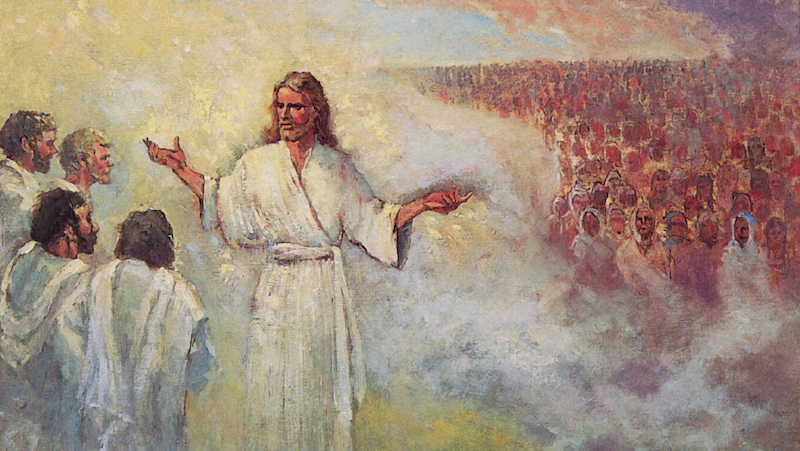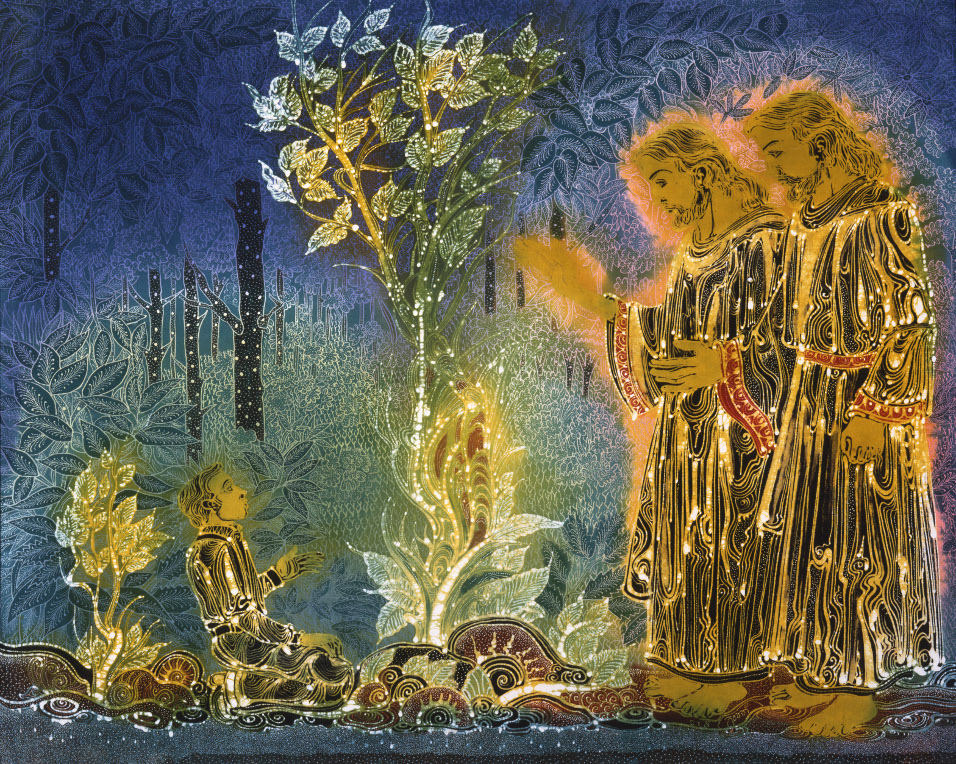Book of Abraham Insight #21
One of the most important doctrinal teachings in the Book of Abraham is that of the pre-mortal existence of humankind and the foreordination of many “noble and great ones” to be rulers on earth (Abraham 3:22–28). Abraham himself was singled out as one who was divinely preordained to a great mission:
Now the Lord had shown unto me, Abraham, the intelligences that were organized before the world was; and among all these there were many of the noble and great ones; And God saw these souls that they were good, and he stood in the midst of them, and he said: These I will make my rulers; for he stood among those that were spirits, and he saw that they were good; and he said unto me: Abraham, thou art one of them; thou wast chosen before thou wast born. (vv. 22–23)
Since the Book of Abraham so clearly teaches the idea of a pre-mortal existence and the divine foreordination of rulers, the question might reasonably be asked whether these teachings find a plausible context in the ancient Near East.
In fact, scholars recognize that Near Eastern peoples believed in the divine foreordination of their kings (and in the case of the ancient Israelites, some of their prophets).1 As one scholar put it, “Divine election—the academic designation for the choosing of people by deity for position and opportunity in mortal life—is a claim that is well attested in ancient Near Eastern texts, including the Hebrew Bible.”2
For example, in a prologue to his famous collection of laws, the ancient Babylonian king Hammurabi (circa 1810–1750 BC), depicted himself as being foreordained by the gods to rule:
When the august God Anu . . . and the god Enlil, lord of heaven and earth, who determines the destinies of the land, allotted supreme power over all the peoples to the god Marduk . . . [a]t that time, the gods Anu and Enlil, for the enhancement of the well-being of the people, named me by my name: Hammurabi, the pious prince, who venerates the gods, to make justice prevail in the land, to abolish the wicked and the evil, to prevent the strong from oppressing the weak, to rise like the sun-god Shamash over all mankind, to illuminate the land.3
The ancient Egyptians of Abraham’s day likewise believed their kings were divinely pre-elected to be rulers. One Egyptian text from Abraham’s time says of the pharaoh Senwosret I (circa 1950–1900 BC): “Men and women surpass exultation in him, now that he is king. He took possession [of kingship] in the egg; his face was toward it from before he was born. Those born with him are multiple, but he is a unique one of the god’s giving.”4 Additional texts from Abraham’s lifetime and many centuries afterwards point to this concept being both prevalent and long-lasting in Egyptian thought.5
Some ancient Egyptian monarchs even went so far as to claim that they were literal divine offspring. At her mortuary temple at Deir el-Bahri, for example, the queen Hatshepsut (who reigned circa 1473–1458 BC) commissioned a series of reliefs depicting herself as the literal daughter of the god Amun-Re who could, accordingly, claim a divine birthright to rule Egypt. The reliefs begin with a depiction of what Egyptologists call a “council of the gods”6 where, in the midst of other important deities, Amun-Re foretells Hatshepsut’s reign, followed by scenes of her divine conception, birth, and ascendency to the throne.7

Abraham appears to have not held any kingly titles in mortality yet was designated a “noble and great one” who was foreordained to be a “ruler” (Abraham 3:22–23). This must certainly at least have been true in a priesthood sense, and unlike the counterfeit priesthood of Pharaoh (Abraham 1:25–28), Abraham’s foreordination to the priesthood was legitimate and ratified through a covenant with God (Abraham 2:6–11).8 Thus, by drawing attention to his foreordained status, Abraham may have been demonstrating how the power and divine authority usually associated with earthly kings was more legitimately and eternally endowed upon worthy holders of the priesthood.
The Book of Abraham’s teachings about foreordination and divine election are therefore important for the eternal truths they preserve and ground the text in a plausible ancient context.
Further Reading
Stephen O. Smoot, “‘Thou Wast Chosen Before Thou Was Born’: An Egyptian Context for the Election of Abraham,” forthcoming.
Dana M. Pike, “Formed in and Called from the Womb,” in To Seek the Law of the Lord: Essays in Honor of John W. Welch, ed. Paul Y. Hoskisson and Daniel C. Peterson (Orem, UT: Interpreter Foundation, 2017), 317–331.
Terryl Givens, When Souls Had Wings: Pre-Mortal Existence in Western Thought (New York, N.Y.: Oxford University Press, 2009), 9–20, 215–216.
Dana M. Pike “Before Jeremiah Was: Divine Election in the Ancient Near East,” in A Witness for the Restoration: Essays in Honor of Robert J. Matthews, ed. Kent P. Jackson and Andrew C. Skinner (Provo, UT: Religious Studies Center, Brigham Young University, 2007), 33–59.
Footnotes
1 Dana M. Pike “Before Jeremiah Was: Divine Election in the Ancient Near East,” in A Witness for the Restoration: Essays in Honor of Robert J. Matthews, ed. Kent P. Jackson and Andrew C. Skinner (Provo, UT: Religious Studies Center, Brigham Young University, 2007), 33–59; “Formed in and Called from the Womb,” in To Seek the Law of the Lord: Essays in Honor of John W. Welch, ed. Paul Y. Hoskisson and Daniel C. Peterson (Orem, UT: Interpreter Foundation, 2017), 317–331.
2 Pike “Before Jeremiah Was,” 33.
3 Martha T. Roth, trans., Law Collections from Mesopotamia and Asia Minor, 2nd ed. (Atlanta, GA: Scholars Press, 1997), 76–77.
4 James P. Allen, Middle Egyptian Literature: Eight Literary Works of the Middle Kingdom (Cambridge: Cambridge University Press, 2015), 87.
5 See for instance Wolfgang Helck, Die Lehre für König Merikare (Wiesbaden: Harrassowitz Verlag, 1977), 83–87; Adrian de Buck, “The Building Inscription of the Berlin Leather Roll,” Studia Aegyptiaca I, Analecta Orientalia 17 (1938): 54; Kenneth A. Kitchen, Ramesside Inscriptions: Historical and Biographical (Oxford: Blackwell, 1976), 2:284, 327, 356; Ramesside Inscriptions: Historical and Biographical (Oxford: Blackwell, 1977), 5:239; Robert K. Ritner, The Libyan Anarchy: Inscriptions from Egypt’s Third Intermediate Period (Atlanta, GA: Society of Biblical Literature, 2009), 477–478.
6 James Henry Breasted, Ancient Records of Egypt (Chicago, Il.: The University of Chicago Press, 1906), 2:78; Edouard Naville, The Temple of Deir el Bahari, Part II, Plates XXV.–LV.: The Ebony Shrine. Northern Half of the Middle Platform (London: The Egypt Exploration Fund, 1897), Pl. XLVI.
7 Naville, The Temple of Deir el Bahari, Part II, 12–18, pls. XLVI–LV; The Temple of Deir el Bahari, Part III, Plates LVI.–LXXXVI: End of Northern Half and Southern Half of the Middle Platform (London: The Egypt Exploration Fund, 1898), 1–9, Pls. LVI–LXVI.
8 See further John Gee, “The Abrahamic Covenant,” in An Introduction to the Book of Abraham (Provo and Salt Lake City, UT: Religious Studies Center, Brigham Young University, and Deseret Book, 2017), 107–113.






